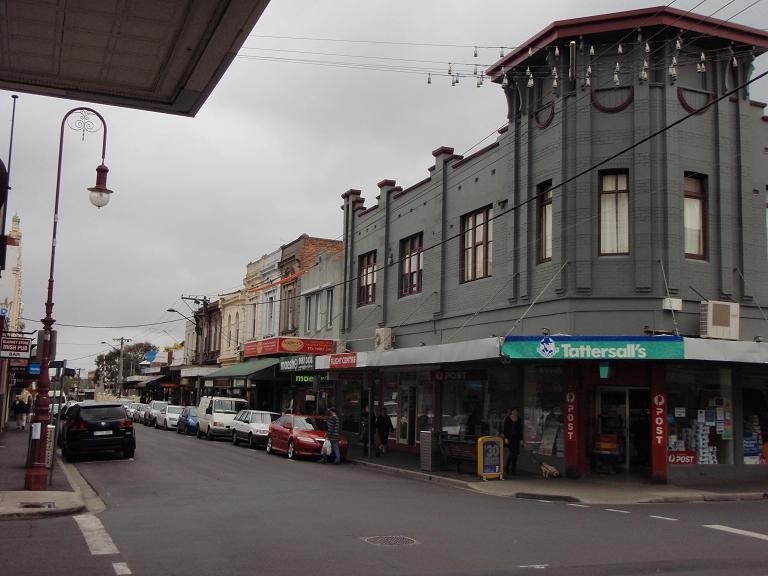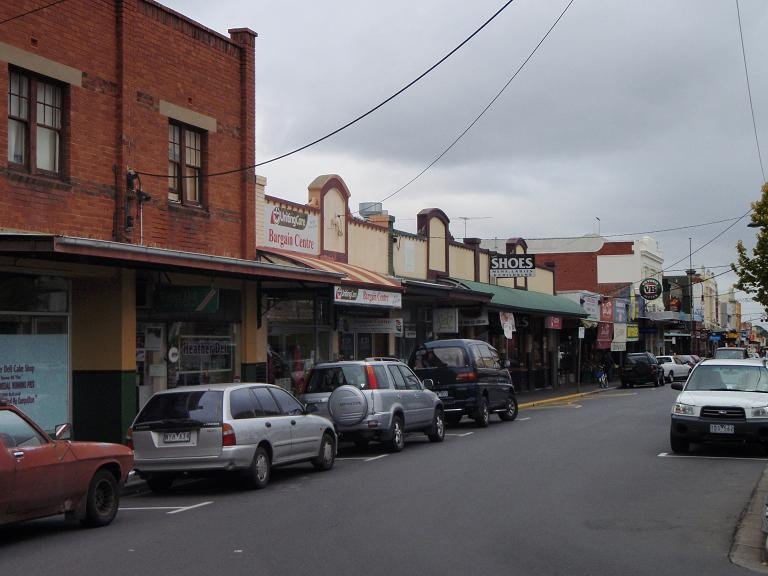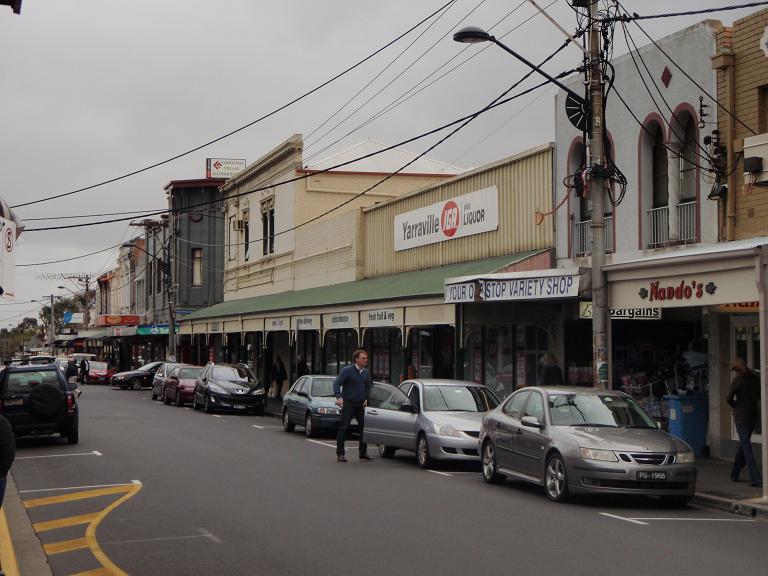Yarraville Civic and Commercial Area
Part Melbourne to Williamstown railway, Anderson, Ballarat, Canterbury, Goulburn, Murray, Simpson, Tarrengower, Wills and Woods Streets (or parts) YARRAVILLE, MARIBYRNONG CITY
-
Add to tour
You must log in to do that.
-
Share
-
Shortlist place
You must log in to do that.
- Download report





Statement of Significance
Statement of Significance
The Yarraville Civic and Commercial precinct is significant to the Western Region of Melbourne because:
- of the architecturally regionally significant commercial streetscapes centred around Anderson and Ballarat Streets which include individually significant places such as the Sun Cinema and the State Savings Bank, as well as significant vistas such as the view north along Ballarat Street to Murray Street, the major corner sites such as the corner of Anderson and Ballarat Streets and the distinctive scale of narrow commercial streets flanked by two storey development (Criteria E1, F1);
- it is expressive of two major development periods in the City's history (Victorian-era, Edwardian-era), with all of the elements which make up an urban area from these periods, such as the transport hub and associated entertainment, civic and commercial buildings close to the station, which still express the dominant Edwardian and Victorian-eras, expressed by:
- Victorian and Edwardian era attached, generally two storey cemented and face brick Edwardian and Victorian era shops and residences over,
- some individually significant inter-war examples and landmark buildings at corners and at the focus of vistas,
- visual prominence of the railway station, stone paved station yards, Anderson Street railway gates and signal box,
- visual prominence of the vista north along Ballarat Street to contributory Murray Street buildings,
- visual prominence of the vista west along Anderson Street to the railway gates and signal box,
- visual prominence of the vista west along Murray Street to the St Georges Theatre,
- visual prominence of the vista north along Birmingham Street to the railway station and St Georges Theatre,
- some surviving early asphalt footpaths and stone kerb and channel,
- siting to the street frontage,
- typically a parapeted and trabeated facade evocative of Italianate design influences,
- near universal parapeted form; and
- a repeating module determined by the Victorian-era shopfronts of 5-6m typical expressed by wall piers (Criteria A3, A4);
- of the early underlying street, subdivision pattern and street names (1859 plan of Yarraville Township) which derive from one of the early private town surveys in the Colony of Victoria and the oldest known private township plan to be created and sold within the City ( Criterion A4); and
- the Yarraville commercial and civic centre has been gathering place for Yarraville residents over a long period of the City's history and as such is still recognised as a community centre, with many of the community's public structures, despite fluctuations in prosperity of the area (Criterion G1).
Australian Heritage Commission (AHC) criteria
The Australian Heritage Commission criteria consist of a set of eight criteria which cover social, aesthetic, scientific, and historic values. Each criterion has sub-criteria written specifically for cultural or natural values. The relevant criteria are:
A.3 richness and diversity of cultural features
A.4 demonstrates well the course and pattern of history, important historic events
D.2 good example of type
E.1 aesthetic importance to the community or cultural group
F.1 design or technological achievement .
G.1 social importance to the community
-
-
Yarraville Civic and Commercial Area - Physical Description 1
The general character of the Yarraville Civic and Commercial Precinct is one of Victorian and Edwardian era attached one and two storey cemented and face brick Edwardian and Victorian era shops with residences over. There are some individually significant inter-war examples and landmark buildings at corners and at the focus of vistas and the area is distinguished by the visual prominence of the railway station, stone paved station yards, Anderson St railway gates and signal box; the visual prominence of the vista north along Ballarat St to contributory Murray St buildings; and the visual prominence of the vista west along Anderson St to the railway gates and signal box. Streets were originally with asphalt footpaths and stone kerb and channel, with some surviving and all properties built to the street frontage. There is typically a parapeted and trabeated facade evocative of Italianate design influences and a near universal parapeted form with a repeating module determined by the Victorian-era shopfronts of 5-6m. Of the 507 places in the precinct as a whole 429 are contributory.
These commercial buildings are grouped around the major transport routes, including the railway, Ballarat, Stephen and Anderson Streets. This civic and commercial core is surrounded by one storey largely Victorian & Edwardian-era residential development.The specific character of the civic-commercial core is defined by Stephen, Lennox, Murray, Ballarat and Anderson Streets. This extends via the railway station yard into Birmingham Street south with its miniature garden square fronting the station, the distinctive 1940s bus shelter and the notable St Georges Theatre. Mid-Victorian era structures exist in Stephen Street, with late Victorian buildings in Lennox and Murray, and combined Edwardian and late Victorian in Ballarat and Anderson Streets. Major buildings from the inter-war period include the Sun Cinema, National Bank and Railway Hotel.
The architectural content of Yarraville's civic-commercial core is still impressive, given the individually worthy designs, sometimes highlighted by the unusual street layout (i.e.. Ballarat Street vista to Murray). However many significant buildings have been altered (28 Murray Street) and among the general building stock, the usual verandah and shopfront replacement has occurred. Nevertheless, the Ballarat Street (to Anderson) and part of Murray Street provide a significant collection of architecturally notable and historically expressive sites.
Among the late 19th century elements in the precinct are the Salvation Army barracks (1887) and the altered but still recognisable fire station (c1895) both in Murray Street, and Punshon & Co.'s stores, at the Ballarat Anderson Streets' corner. The Yarraville Hall (later Lyric Theatre) is a major related development in the old Stephen St centre, outside of this precinct. The railway station (1893) provides a visual and cultural focus of the precinct, surrounded by its stone pitched goods yards.
The Edwardian-era structures include the State Savings Bank (1909), Gill's Drapery at the Ballarat and Anderson corner, the nearby Woods' Drapery (1917) with its corner tower rotunda and slightly removed from the centre, the St. George's Theatre (1913) in Birmingham Street. This theatre remains today as a termination of the vista across the railway yards from Murray St. The notable Sun Cinema of 1938 represents the minor inter-war phase, along with the rebuilt Railway Hotel.
Part of the 1859 township plan lies outside of the heritage overlay area, where the existing building stock was judged to be below the study threshold for adequate expression of the historical themes and satisfaction of the Australian Heritage Commission criteria. However the township plan itself is of significance as evoked by the street and subdivision pattern and street names which survive from its creation date.Yarraville Civic and Commercial Area - Physical Conditions
Physical Conditions: fair (disturbed, reasonably preserved)
Yarraville Civic and Commercial Area - Integrity
Integrity: partially intact/intrusions
Yarraville Civic and Commercial Area - Historical Australian Themes
Thematic context
Australian Principal Theme Developing local, regional and national economies
PAHT Subtheme Marketing & retailing
Local Theme(s) Village and township reserves
Yarraville Civic and Commercial Area - Physical Description 2
Map (Melway)
Boundary description Part of the Melbourne to Williamstown railway; parts of Ballarat , Anderson, Birmingham, Canterbury and Murray Streets, with emphasis on all original Edwardian-era and Victorian-era elements, including basalt pitched paving, asphalt footpaths, lot sizes and street patterns.
Heritage Significance Regional
Creation date(s) 1849-
Local Government Area City of Maribyrnong
Ownership Type Private & PublicHeritage Study and Grading
Maribyrnong - Maribyrnong Heritage Review
Author: Jill Barnard, Graeme Butler, Francine Gilfedder & Gary Vines
Year: 2000
Grading:
-
-
-
-
-
SUN THEATRE
 Victorian Heritage Register H0679
Victorian Heritage Register H0679 -
STATE SAVINGS BANK
 Victorian Heritage Register H0723
Victorian Heritage Register H0723 -
YARRAVILLE RAILWAY STATION COMPLEX
 Victorian Heritage Register H2447
Victorian Heritage Register H2447
-
Archaeological site
 Southern Grampians Shire
Southern Grampians Shire -
Avoca
 Stonnington City H0809
Stonnington City H0809 -
BANYULE
 Victorian Heritage Register H0926
Victorian Heritage Register H0926
-
-











